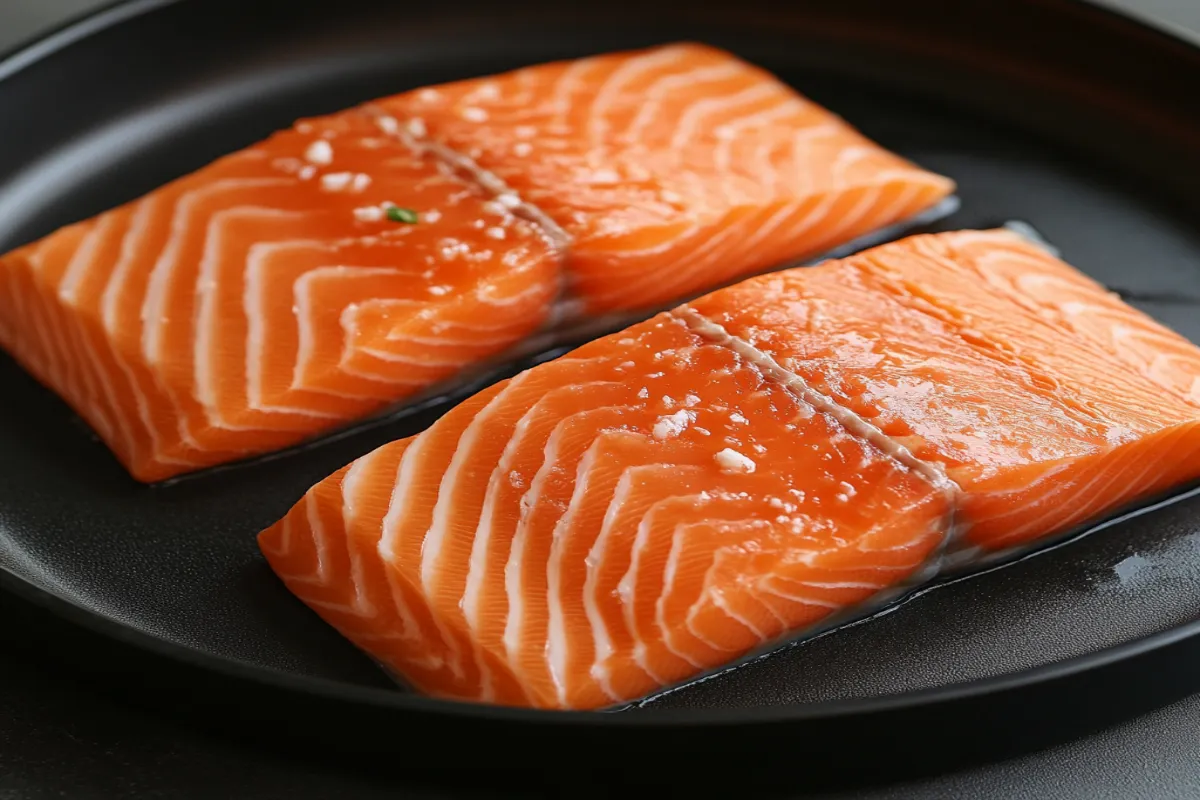Salmon is a beloved fish, known for its richness in omega-3 fatty acids, protein, and vitamins. However, like all seafood, salmon spoils quickly. Thus, knowing how can you tell if cooked salmon has gone bad is essential. Consuming spoiled salmon can lead to food poisoning, which poses significant health risks. Therefore, this guide will help you identify when your cooked salmon has spoiled and teach you how to store it safely to prevent spoilage.
Recognizing how can you tell if cooked salmon has gone bad is important to prevent food waste and protect your health. Moreover, with the right storage techniques, you can extend its freshness and enjoy your meal without worry.
Key Indicators of Spoiled Cooked Salmon
If you’re wondering how can you tell if cooked salmon has gone bad, there are a few key indicators you can rely on. Generally, spoiled salmon shows noticeable changes in smell, texture, and appearance.
1. Smell
The smell is one of the most obvious ways to detect if your salmon has spoiled. Freshly cooked salmon should have a mild scent, but when it goes bad, it develops a sour, rancid, or ammonia-like odor. If you notice a strong, unpleasant smell, it’s a clear sign that the salmon is no longer safe to eat. In fact, if you detect this foul odor before or after cooking, it’s best to discard the fish immediately.
Since cooking cannot mask the odor, it’s important to check for these smells even after storing the fish. This way, you can avoid consuming spoiled salmon that could harm your health.
2. Texture
Another way to tell if cooked salmon has gone bad is through its texture. Fresh salmon should have a firm, flaky consistency. On the other hand, slimy, sticky, or overly soft texture is a sign of spoilage. Salmon that feels slimy is no longer safe to eat, as bacteria have likely developed on the surface.
As you handle the salmon, it should remain intact. If it breaks apart into mushy chunks, this indicates that the fish has gone bad. Therefore, whenever you notice these texture changes, discard the salmon immediately.
3. Appearance
Besides smell and texture, appearance can tell you a lot about the freshness of your salmon. To determine how can you tell if cooked salmon has gone bad, examine its color. Fresh salmon is typically bright pink or orange, but if it turns dull or grayish, it’s likely spoiled. Additionally, a milky or translucent film on the surface is another sign that the fish has gone bad.
Thus, if your salmon doesn’t look as fresh as it did before, it’s better to err on the side of caution and throw it out. These visual clues are strong indicators that your salmon is no longer safe to eat.
For more tips on how to keep your salmon fresh and avoid spoilage, check out this guide on salmon storage and freshness.
Other Signs of Spoilage
In addition to the key indicators mentioned earlier, there are other signs that help answer the question, how can you tell if cooked salmon has gone bad?
1. Mushy Flesh
While cooked salmon should remain firm, improper storage can cause it to develop a mushy texture. If the salmon becomes mushy after thawing, freezer burn may be to blame. Freezer-burned salmon is still safe to eat, although the texture and taste might not be as good as fresh salmon.
However, if the salmon feels unusually mushy or soft, it could indicate spoilage. In that case, it’s better not to consume the fish.
2. Visible Mold or Spoilage Bacteria
If you notice mold growing on your cooked salmon, it’s an immediate sign that it has gone bad. Even if the mold appears only in one area, you should discard the entire portion, as mold can spread. Spoilage bacteria can also cause the fish to develop slime or unusual spots, which further confirms that the salmon has spoiled.
For additional guidance on how long salmon remains safe, check out this article.
How to Store Cooked Salmon Safely
To avoid ever asking how can you tell if cooked salmon has gone bad, proper storage is key. Storing cooked salmon correctly helps keep it fresh for as long as possible, preventing both spoilage and waste.
1. In the Refrigerator
If you plan to eat your cooked salmon within a few days, store it in the fridge. Use an airtight container to prevent air exposure, which speeds up spoilage. When stored properly, cooked salmon can last 3-4 days in the refrigerator. However, always ensure your fridge remains below 40°F (4°C) to slow bacterial growth.
2. In the Freezer
On the other hand, if you don’t intend to eat the salmon right away, freezing is the best option. Cooked salmon can last for up to 3 months in the freezer. For optimal freshness, freeze it as soon as possible after cooking. Wrap the fish tightly in plastic wrap or foil, and store it in a freezer-safe container to avoid freezer burn.
To learn more about safe storage practices, refer to this guide on how long cooked salmon lasts in the fridge.
Salmon Shelf Life: How Long Is Cooked Salmon Safe to Eat?

If you are trying to determine how can you tell if cooked salmon has gone bad, understanding its shelf life is essential. The following table provides a quick reference for how long you can safely store salmon under various conditions:
| Salmon Type | Room Temperature | Refrigerated | Frozen |
|---|---|---|---|
| Raw | No more than 2 hours | 1-2 days | 2-3 months |
| Cooked | No more than 2 hours | 3-4 days | 3 months |
As a general rule, cooked salmon should never be left out at room temperature for more than 2 hours. Once the fish exceeds this time limit, it’s no longer safe to eat.
Common Mistakes That Lead to Spoiled Salmon
To keep your salmon fresh, it’s important to avoid common mistakes that may cause it to spoil more quickly. Let’s explore a few of these mistakes that could cause you to question how can you tell if cooked salmon has gone bad.
1. Leaving Salmon Out at Room Temperature
Leaving cooked salmon out at room temperature for too long is a surefire way to spoil it. Bacteria multiply quickly between 40°F and 140°F, so always refrigerate or freeze the salmon shortly after cooking to prevent spoilage.
2. Improper Sealing and Storage
Another common mistake is not sealing your salmon properly before storing it. Air exposure speeds up spoilage by allowing bacteria to grow. To avoid this, always store your salmon in airtight containers or wrap it tightly before refrigerating or freezing.
3. Using Improper Thawing Methods
If you’ve frozen your salmon, proper thawing is crucial. Defrosting salmon on the counter can allow bacteria to grow rapidly, leading to spoilage. Instead, thaw your salmon in the refrigerator or use cold water thawing to ensure safety.
For more advice on how to prepare other meals safely, check out this guide on mashed potatoes.
Thawing and Reheating Cooked Salmon Safely
If you’ve stored your cooked salmon in the freezer, knowing how to thaw and reheat it properly is just as important as storing it. This ensures you avoid spoilage and enjoy your meal safely.
1. Refrigerator Thawing
Thawing salmon in the fridge is the safest method. It’s slower, but it keeps the salmon at a consistent temperature, preventing bacterial growth.
2. Cold Water Thawing
For a quicker thaw, place your salmon in a sealed plastic bag and submerge it in cold water. Change the water every 30 minutes to ensure it stays cold enough.
3. Microwave Thawing
Although it’s not the preferred method, you can thaw salmon in the microwave if needed. Use the defrost setting and monitor the fish carefully to avoid overcooking parts of it.
Once thawed, reheat the salmon to an internal temperature of 145°F to ensure it’s safe to eat.
Health Risks of Eating Spoiled Salmon
Understanding how can you tell if cooked salmon has gone bad is crucial for protecting your health. Eating spoiled salmon can lead to several health risks, including foodborne illnesses.
1. Foodborne Illnesses
Spoiled salmon may contain harmful bacteria like Salmonella and Listeria. Consuming salmon contaminated with these bacteria can cause food poisoning, resulting in symptoms like nausea, vomiting, and diarrhea.
2. Allergic Reactions
In some cases, eating spoiled seafood can trigger allergic reactions, even in those without known seafood allergies. Symptoms range from mild itching to severe breathing difficulties.
For more information on how long leftover salmon is safe, check out this resource.
Frequently Asked Questions (FAQs)
How can you tell if cooked salmon has gone bad?
You can tell if cooked salmon has gone bad by checking for a sour or fishy smell, slimy texture, and discolored appearance.
What happens if you eat bad cooked salmon?
Eating bad salmon can lead to food poisoning, which causes symptoms such as nausea, vomiting, and diarrhea.
Can cooked salmon go bad in the fridge?
Yes, cooked salmon can spoil in the fridge after 3-4 days. Always inspect for signs of spoilage before eating.
How long does it take for cooked salmon to spoil?
If left at room temperature, cooked salmon can spoil in as little as two hours.
Can you eat cooked salmon after 5 days?
It’s not safe to eat cooked salmon after five days in the fridge. It’s recommended to consume it within 3-4 days.
Conclusion
Understanding how can you tell if cooked salmon has gone bad is essential for enjoying your meals safely. By paying attention to smell, texture, and appearance, you can easily identify whether your salmon is still fresh. Additionally, proper storage, thawing, and reheating methods can help you extend the life of your cooked salmon and avoid foodborne illnesses.
If you’re ever unsure, it’s best to discard the salmon and prevent potential health risks. Following these guidelines will help you enjoy fresh, safe salmon every time. For more tips on salmon storage, refer to this detailed guide.

